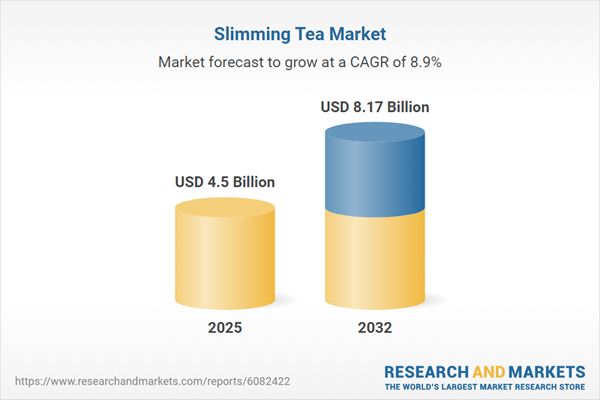Speak directly to the analyst to clarify any post sales queries you may have.
The slimming tea market is redefining how wellness brands and retailers approach functional beverages and consumer engagement. With expanding product formats and shifting consumer expectations, senior leaders are challenged to anticipate changes and make strategic, data-driven decisions for growth and resilience.
Market Snapshot: Slimming Tea Market Size and Growth
The Slimming Tea Market grew from USD 4.14 billion in 2024 to USD 4.50 billion in 2025 and is projected to achieve a CAGR of 8.86%, reaching USD 8.17 billion by 2032. This strong upward trajectory reflects ongoing demand for wellness solutions, rising consumer awareness about natural health products, and industry innovations in both formulation and distribution.
Scope & Segmentation
This report offers a comprehensive analysis of the slimming tea sector, focusing on segmentation by format, channel, ingredient, end user, region, and company. Key segmentation categories include:
- Product Format: Liquid Concentrate, Loose Leaf, Powder, Tea Bags
- Distribution Channel: Offline Retail (Convenience Stores, Pharmacies, Specialty Stores, Supermarkets and Hypermarkets), Online Retail (Brand Website, E-Commerce Platforms)
- Ingredient Type: Fruit Infusion, Green Tea Extract, Herbal Infusion, Oolong Extract
- End User: Men, Unisex, Women
- Region: Americas (United States, Canada, Mexico, Brazil, Argentina, Chile, Colombia, Peru), Europe (United Kingdom, Germany, France, Russia, Italy, Spain, Netherlands, Sweden, Poland, Switzerland), Middle East (United Arab Emirates, Saudi Arabia, Qatar, Turkey, Israel), Africa (South Africa, Nigeria, Egypt, Kenya), Asia-Pacific (China, India, Japan, Australia, South Korea, Indonesia, Thailand, Malaysia, Singapore, Taiwan)
- Key Companies: Unilever PLC, Tata Consumer Products Limited, Associated British Foods plc, Hain Celestial Group, Inc., Ito En, Ltd., Nestlé S.A., McCormick & Company, Inc., Marico Limited, Ten Ren Tea Co., Ltd., Starbucks Corporation
Key Takeaways: Strategic Insights for Leaders
- Product design in this category has evolved beyond traditional teas, with innovation focused on convenience, authenticity, and health outcomes.
- Distribution is moving toward omnichannel models, as brands embrace digital sales and direct-to-consumer possibilities in parallel with legacy retail.
- Ingredient blends are increasingly sophisticated, integrating adaptogens, superfruits, and science-backed botanicals to meet diverse consumer goals.
- Consumer engagement now centers on lifestyle alignment and community, driven by influencer collaborations, virtual experiences, and user-generated feedback.
- Regional markets display distinct patterns—regulatory frameworks, consumer preferences, and retail models all impact brand performance and strategy diversification.
- Collaborative initiatives, such as partnerships with wellness experts and sustainability commitments, are emerging as critical differentiators in brand positioning.
Tariff Impact: Navigating Trade Policy and Supply Chains
Recent trade tariffs on tea and botanicals have complicated sourcing and procurement strategies. Companies are exploring new supplier relationships and localized cultivation to manage higher raw material costs. Adjustments to production and pricing models are responsive to these external pressures, with market leaders emphasizing value beyond price to maintain consumer loyalty and protect margins.
Methodology & Data Sources
This market intelligence report uses both secondary research from botanical publications and trade associations and primary data gathered from interviews with supply chain executives and product development teams. Online surveys and focus groups were also deployed to capture evolving consumer sentiment and supplier dynamics.
Slimming Tea Market: Why This Report Matters
- Uncovers core trends, regulatory impacts, and innovation pathways shaping growth and competitive dynamics in the slimming tea sector.
- Enables data-driven operational and expansion strategies tailored to changing consumer preferences and regional market differences.
- Supports better decision-making by highlighting leading companies, best-in-class product strategies, and the importance of supply chain agility in volatile contexts.
Conclusion
The slimming tea market continues to evolve through innovation, channel diversification, and region-specific strategies. Decision-makers can use these insights to anticipate shifts, optimize investments, and capture new category opportunities with greater confidence.
Table of Contents
3. Executive Summary
4. Market Overview
7. Cumulative Impact of Artificial Intelligence 2025
Companies Mentioned
The companies profiled in this Slimming Tea market report include:- Unilever PLC
- Tata Consumer Products Limited
- Associated British Foods plc
- Hain Celestial Group, Inc.
- Ito En, Ltd.
- Nestlé S.A.
- McCormick & Company, Inc.
- Marico Limited
- Ten Ren Tea Co., Ltd.
- Starbucks Corporation
Table Information
| Report Attribute | Details |
|---|---|
| No. of Pages | 195 |
| Published | October 2025 |
| Forecast Period | 2025 - 2032 |
| Estimated Market Value ( USD | $ 4.5 Billion |
| Forecasted Market Value ( USD | $ 8.17 Billion |
| Compound Annual Growth Rate | 8.8% |
| Regions Covered | Global |
| No. of Companies Mentioned | 11 |









